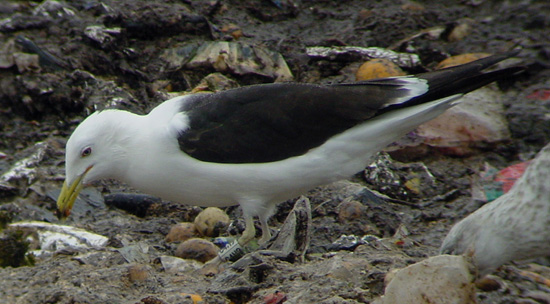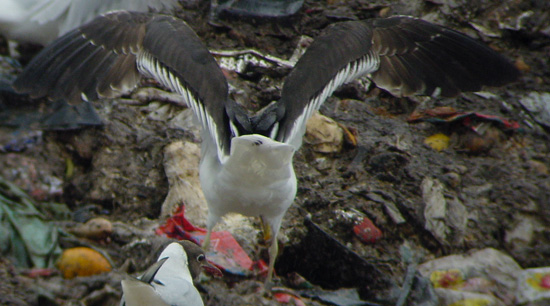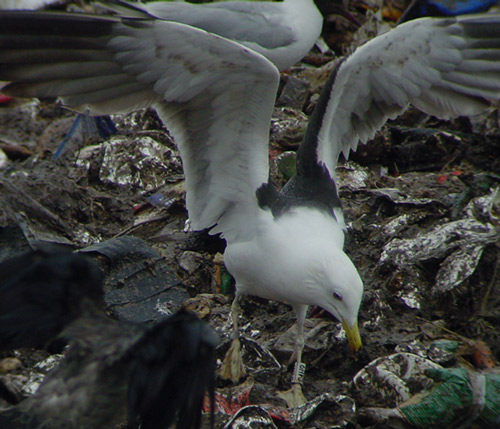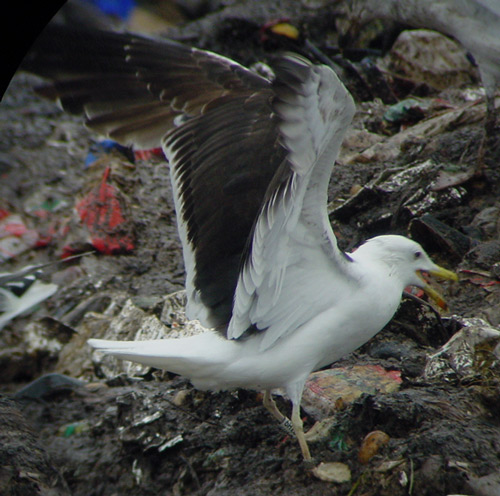
(4 images) Larus fuscus fuscus 3cy C4H9, July 11 2003, Tampere, Finland (61.33N 24.59E).
C4H9 was ringed in Pälkäne, Finland
(61,21N
24,23E);
ringed as pullus on June 25 2001.
Recorded
at Tampere:
2003-05-21,
2003-05-24,
2003-05-29, 2003-05-31, 2003-06-01, 2003-06-03, 2003-06-05, 2003-06-14,
2003-06-16, 2003-06-17, 2003-06-18, 2003-06-20, 2003-06-22, 2003-07-05,
2003-07-06, 2003-07-09, 2003-07-11, 2003-07-20, 2003-07-23, 2003-07-31,
2003-08-02, 2003-08-03,
Larus fuscus fuscus in 2cy often returns
with completely replaced primaries and secondaries. In 3cy, fuscus more
often shows a clear division between fresh inner primaries and older outer
primaries, the inner primaries often showing neat white tips and the outer
primaries often second generation-like with rounded tips and paler bleached
brown. The arrested moult in the primaries is often reflected in the secondaries
and (to a less extend) in the tail-feathers as well. The older tail-feathers
(often R5 is older) still show a broad dark sub-terminal band.
3cy fuscus often have some black markings on the bill, which is otherwise
much adult-like, with a clear red gonydeal spot. The colour of the naked parts
are adult-like as well.
The scapulars in 3cy are often completely adult-like, lacking internal patterns;
plain blackish grey with a mahogany hue on the older feathers. Most wing-coverts
and tertials are adult-like blackish grey as well, but often 3cy birds show some
very bleached pale brown wing-coverts, normally in the greater covert bar and in
the upper rows of the lesser coverts. These bleached wing-coverts accentuate the
jumpy sequence in the last wing-covert moult cycles, as there is often no clear
pattern in location of these bleached feathers. Head and body feathers normally
are snow-white by July.
C4H9 was ringed as pullus in 2001, now in 3cy. The primary moult stage in this 3cy: P1 is growing. P2 is missing. P3-P4 are probably old 3rd generation, moulted exactly a year ago in summer 2000, now worn at the tips and the grey centre bleached pale brown. P5 was moulted more recently, with a clear sub-terminal band. P6-P10 are probably old 2nd generation, but in wear similar to of P2-P4. The primary moult is completely symmetric. The outer primaries are paler bleached brown with only small white crescents on the very tip and no mirror on P10. Tail-feathers 3rd generation but S1, the outermost secondary still old.



